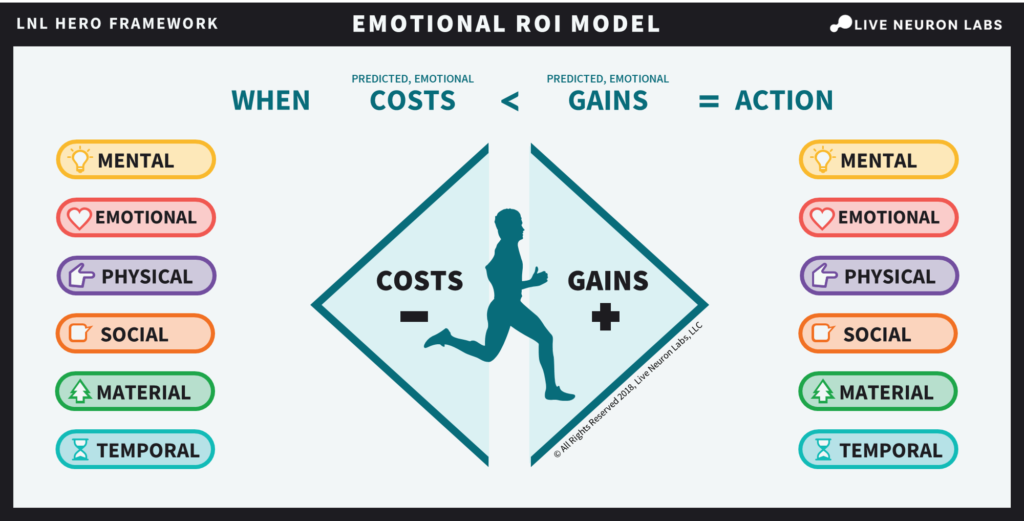Your team has painstakingly developed something that will help a lot of people. You’ve researched, designed, tested, and produced it.
Then you launch. And…crickets.
People aren’t trying it. And if they do, they aren’t sticking with it.
Your heart sinks. The team is frustrated. The CEO is mad.
Why!!!???
Why aren’t people doing something that would so obviously help them?
And why do we all have trouble doing things that are good for us — like exercising, saving money, or eating healthier?
New research in behavioral science is revealing the answers. Recent discoveries have overturned many previously held beliefs about human behavior. And the exploding field of behavioral design applies these insights to effectively drive target behaviors.
Leveraging decades of experience, Live Neuron Labs has developed the Emotional ROI (eROI) model to make behavioral design much more methodical and practical. This powerful tool can be easily applied to any design challenge to improve engagement and behavioral outcomes.
To Act or Not to Act?
When considering potential actions, our brains perform a flurry of parallel evaluations to predict potential costs and gains. Some of these are conscious. Some are non-conscious. But all of them are evaluating how the action will affect our emotional state.
“What do I have to gain from doing this? What could I lose? Will it make me feel better or worse?”
If the predicted emotional costs (eCosts) outweigh the predicted emotional gains (eGains), then the person won’t perform the action in question. But if the predicted eGains outweigh the eCosts, they will.
To increase engagement in any experience you’re designing, vigorously trim the predicted eCosts, and generously sprinkle in a variety of eGains.
Let’s Get Emotional
“Great,” you say. “I’ll just list the facts about all the benefits they’ll get from my product. People will clearly see that the gains outweigh the costs.”
Not so fast! To drive action, we need to think less in terms of logical arguments strictly based on things like money, time, or effort. Instead, we need to focus on emotions. That’s why the model is called “Emotional ROI.”
A variety of studies have demonstrated a critical point: decisions are driven by emotions arising from the nonconscious mind, not by evaluations in the conscious, cognitive mind. We use phrases like, “I feel really good about this,” for a reason!
Decision-making is fundamentally about predicting which options will improve our emotional state the most. And usually, we want to feel better NOW. We’re especially terrible at considering future gains when they require sacrifices now. Skip this milkshake now so I can avoid diabetes in ten years? No thanks. “One chocolate milkshake, please!”
The 6 Dimensions of Experience
Unfortunately, the most important types of eGains and eCosts are generally underappreciated. If they’re considered at all, people don’t recognize how critically important they are.
To help solve this problem, we introduced the “6 Dimensions of Experience”, a simple model in plain English that makes it easy to systematically perform an eROI analysis.
The 6 Dimensions of Experience are Mental, Emotional, Physical, Social, Material, and Temporal.
By systematically considering each dimension when doing eROI analysis, you’ll discover important behavioral hurdles and opportunities. The goal is to ruthlessly minimize as many eCosts as you can and really boost the eGains. They don’t have to be big eGains. A steady, varied stream of small eGains is actually more practical and effective at driving behavior.
Now let’s define each of the 6 Dimensions, and look at some common types of eGains and eCosts for each. Remember:
“eCosts” deter action.
“eGains” promote action.
 Mental Dimension
Mental Dimension
The mental dimension refers to activities that are consciously effortful for your brain. This is known as “executive function,” and the effort required contributes to “cognitive load.” Research has shown that anticipated cognitive effort is much more of a deterrent than you would expect. Don’t make people think too hard!
Mental eCosts Include:
- Decisions
- Options
- Focusing
- Calculating
- Reading
- Remembering
- Willpower
- And generally trying to figure things out
Mental eGains Include:
- Aha! moments
- Humor, whimsy
- Novelty, surprise
- New insights
- Curiosity satisfied
- Clarity
 Physical Dimension
Physical Dimension
The physical dimension refers to our senses and motor function. You can think of these as the inputs and outputs that our brains use for interacting with the world.
Physical eCosts Include:
- Physical effort
- Pain
- Endurance
- Strength
- Coordination
- Sensory overload
- Straining the senses
Physical eGains Include:
- Laughter
- Stretching
- Relaxed breathing
- Hugs
- High-fives
- Quick motions
 Emotional Dimension
Emotional Dimension
The emotional dimension refers to things that trigger automatic emotional responses. Avoid elements that have negative associations for your audience. Add elements that have positive associations.
Emotional eCosts Include
- Math (triggers anxiety for many)
- Red error messages (enhances shame and embarrassment)
- Angry faces (triggers anger or fear)
- Violent imagery (triggers fear)
- Sad faces or imagery (triggers sadness)
- Scary imagery like illness, insects, or blood
Emotional eGains Include
- Encouraging, positive language
- Bright colors
- Beauty
- Scenic landscapes
- Happy faces
- Cuteness
- Humor
- Whimsy
 Social Dimension
Social Dimension
The social dimension may be the most important one. Humans need social connection and cooperation to survive. Complex social collaboration is the primary human advantage. Therefore we’re deeply wired to crave belonging, esteem, and respect.
Social eCosts Include
- Rejection
- Embarrassment
- Defying social norms
- Asking for favors
- Conflict
Social eGains Include
- Belonging
- Esteem & respect
- Acknowledgment
- Empathy
- Support
- Encouragement
 Material Dimension
Material Dimension
The material dimension refers to everything besides humans (like money, resources, tools, cues, and obstacles.) It also includes digital things (like upvotes, follows, likes, shares, points, and digital goods).
Material eCosts Include
Losing:
- Money & other currency
- Resources
- Tools
- Assets
- Perks
- Prizes
- Privileges
- Digital rewards
Material eGains Include
Getting:
- Money & other currency
- Resources
- Tools
- Assets
- Perks
- Prizes
- Privileges
- Digital rewards
 Temporal Dimension
Temporal Dimension
This refers to all the ways time factors in. The most important thing to remember is that humans tend to weight immediate costs and gains FAR more than future ones. It’s important to design a continuous flow of little immediate eGains. Design as if future eCosts and eGains don’t exist.
Temporal eCosts Include:
- Delays
- Time investments
- Patience
- Loss of control over time
- eCosts experienced earlier than expected
Temporal eGAINS Include:
- Time-savings
- Instant gratification
- Longer lasting rewards
- Rewards coming sooner than expected
- Gaining more control over time

How will you use it?
Now you know the basics of the eROI model. Soon you’ll be naturally spotting potential eCosts and eGains everywhere. You can use eROI to improve emails, social posts, product designs, services, events, activities — pretty much any time people aren’t doing what’s best for them!
Here at Live Neuron Labs we use this model (and many others) to design large-scale, positive behavior change programs for social good. We also provide consulting, workshops, presentations, keynotes, and behavioral design training. To learn more, email us at: inquiries@LiveNeuronLabs.com.

